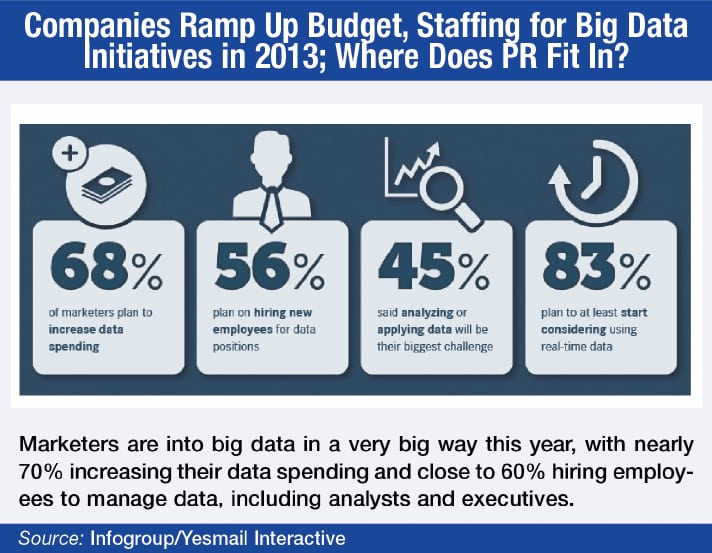 |
When compared in stature with its business buzzword brethren—“gamification,” “freemium,” “intellectual capital,” etc.—“big data” holds its own quite well. A recent study by Infogroup and Yesmail Interactive supports that conclusion. The study finds that marketers plan to go on a big data spending spree in 2013, hiring employees and building systems to keep up with the fire hose of information being generated by a growing number of digital and social channels.
The study, which took the pulse of 700 marketers, found that nearly 70% of companies plan to spend more on data initiatives in 2013. More than half of the respondents plan on adding people to oversee their data efforts this year.
The study also said that the big-data trend will significantly impact corporate budgets in 2013, as marketers place a growing emphasis on analytics, real-time data and integrated multichannel marketing.
The $64,000 question: We now know what big data means to marketers in 2013, so what does it mean specifically to PR executives? Just how big should big data figure into communications plans?
Mark Weiner, CEO of PRIME Research North America, says the term isn’t new. “Big data is being used in quotations as if it’s a new idea,” Weiner says. “Really, lots data has been available to a lot of people for quite some time.”
Leading today’s big data explosion is technology that’s enabling the collection of more data—like social media, supermarket scanning data and chips embedded in credit cards—and the technology surrounding the warehousing of such data, Weiner says.
So while there’s always been a plethora of data, the challenge has been making sense of it, Weiner says. “The assumption has been that PR is behind the data curve when compared to advertising and marketing,” he says. “It’s true that PR has been slower to adapt, but it’s also been more open in recognizing the challenges.”
Don Patrick, president of Infogroup Targeting Solutions, agrees that dealing with data is a problem for PR. Which is why more resources are being tapped to handle big data. The biggest pitfall: “People try to solve the problem in one huge play, and it’s an incremental play,” says Patrick. “You get data, analyze it and know exactly where you want to go from a customer perspective.”
SOCIAL DATA
With many PR executives pulling the social media strings, social data is becoming the PR equivalent to marketing’s big data. The study found that this year 80% of respondents plan to use more of customers’ social media data to drive campaigns in other channels.
“Social media is crossing borders within organizations, so it’s not just within PR,” Weiner says. In a way, social data helps PR executives level the playing field with marketing. While representing a small percentage of marketing spend, social media PR drives a disproportionate positive volume in sales, Weiner says.
The study also provides additional insights into data and communications trends Among the findings:
• The majority of marketers use insights from customer data to drive marketing campaigns on their website (83%), email (72%) and social media (59%).
• Less than half use customer data to drive marketing campaigns through the offline channels of direct mail (47%), print (32%) and telemarketing (30%).
• Almost half the respondents say their website is the best source of gathering customer data, followed by email (19%) and social media (12%).
Bottom line: PR programs can certainly benefit from big data, but it requires a disciplined, strategic approach—something that PR executives now are more in tune with. PRN
CONTACT:
Mark Weiner, @WeinerMark; Don Patrick, @Infogroup.
Follow Scott Van Camp: @svancamp01
